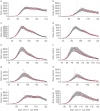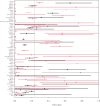Estimates of the ongoing need for social distancing and control measures post-"lockdown" from trajectories of COVID-19 cases and mortality
- PMID: 32482785
- PMCID: PMC7263071
- DOI: 10.1183/13993003.01483-2020
Estimates of the ongoing need for social distancing and control measures post-"lockdown" from trajectories of COVID-19 cases and mortality
Abstract
By 21 May 2020, severe acute respiratory syndrome-coronavirus-2 (SARS-CoV-2) had caused more than 5 million cases of coronavirus 2019 (COVID-19) across more than 200 countries. Most countries with significant outbreaks have introduced social distancing or "lockdown" measures to reduce viral transmission. So the key question now is when, how and to what extent these measures can be lifted.Publicly available data on daily numbers of newly confirmed cases and mortality were used to fit regression models estimating trajectories, doubling times and the reproduction number (R0) of the disease, before and under the control measures. These data ran up to 21 May 2020, and were sufficient for analysis in 89 countries.The estimates of R0 before lockdown based on these data were broadly consistent with those previously published: between 2.0 and 3.7 in the countries with the largest number of cases available for analysis (USA, Italy, Spain, France and UK). There was little evidence to suggest that the restrictions had reduced R far below 1 in many places, with France having the most rapid reductions: R0 0.76 (95% CI 0.72-0.82) based on cases, and 0.77 (95% CI 0.73-0.80) based on mortality.Intermittent lockdown has been proposed as a means of controlling the outbreak while allowing periods of increased freedom and economic activity. These data suggest that few countries could have even 1 week per month unrestricted without seeing resurgence of the epidemic. Similarly, restoring 20% of the activity that has been prevented by the lockdowns looks difficult to reconcile with preventing the resurgence of the disease in most countries.
Copyright ©ERS 2020.
Conflict of interest statement
Conflict of interest: M. Lonergan has nothing to disclose. Conflict of interest: J.D. Chalmers has received research grants from GlaxoSmithKline, Boehringer Ingelheim, AstraZeneca, Pfizer, Grifols, Bayer AG, Polyphor and Insmed; and received consultancy, congress travel or speaker fees from GlaxoSmithKline, Bayer Healthcare, Aradigm Corporation, Grifols, Pfizer, Boehringer Ingelheim, Napp and Insmed.
Figures




Comment in
-
Correlation and causality: a COVID-19 conundrum.Eur Respir J. 2020 Oct 15;56(4):2003174. doi: 10.1183/13993003.03174-2020. Print 2020 Oct. Eur Respir J. 2020. PMID: 32859679 Free PMC article.
-
A cuckoo COVID coincidence?Eur Respir J. 2020 Oct 15;56(4):2003236. doi: 10.1183/13993003.03236-2020. Print 2020 Oct. Eur Respir J. 2020. PMID: 32907889 Free PMC article.
References
-
- European Centres for Disease Prevention and Control COVID-19 situation update worldwide, as of 8 June 2020 www.ecdc.europa.eu/en/geographical-distribution-2019-ncov-cases Date last updated: 8 June 2020; date last accessed: 22 May 2020.
MeSH terms
LinkOut - more resources
Full Text Sources
Medical
Miscellaneous
